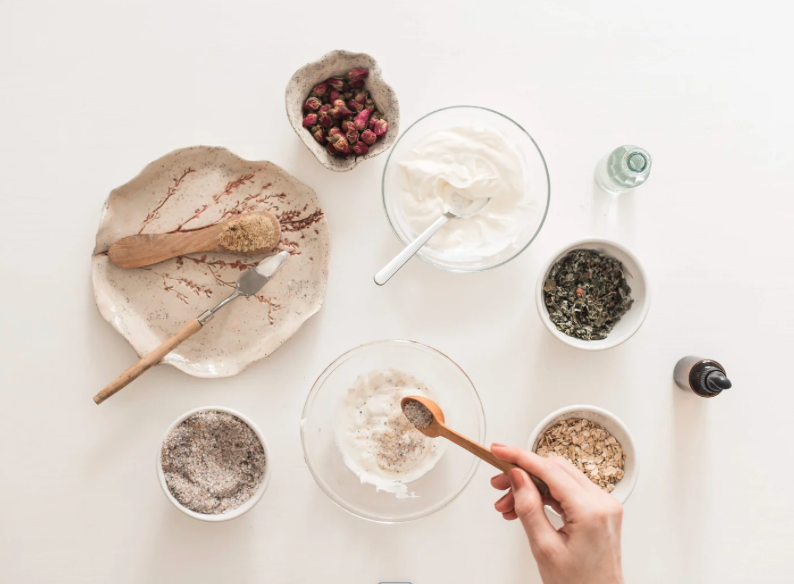
“Not-So-Clean” Skincare: 15 Common Ingredients We Skip (and What to Use Instead)
A quick word on “clean”
“Clean” isn’t a regulated term. Our bar is simple: fewer questionable chemistries, more skin-native nourishment, full label clarity. If it stresses the skin barrier or adds avoidable risk, we skip it.
The List: 15 “Not-So-Clean” Ingredients (and Label Clues)
-
PEGs / Ethoxylated compounds
Used for: emulsifying, slip, solubilizing.
Concerns: can be contaminated with 1,4-dioxane (a manufacturing by-product); can increase penetration on compromised skin.
Label clues: PEG-8, PEG-40, PEG-100 stearate, ceteareth-20, laureth-7, steareth-21. -
Parabens
Used for: preservation.
Concerns: many shoppers avoid due to endocrine-disruption debates; easy swaps exist.
Label clues: methylparaben, propylparaben, butylparaben, ethylparaben. -
Phthalates
Used for: plasticizers; often hidden in fragrance.
Concerns: exposure concerns; lack of label transparency when bundled as “fragrance.”
Label clues: diethyl phthalate (DEP); avoid generic “fragrance/parfum.” -
Synthetic fragrance / “Parfum”
Used for: scent.
Concerns: umbrella term for thousands of compounds; top trigger for sensitivity.
Label clues: fragrance, parfum, aroma. -
Formaldehyde-releasing preservatives
Used for: preservation.
Concerns: slow-release formaldehyde; sensitization concerns.
Label clues: DMDM hydantoin, imidazolidinyl urea, diazolidinyl urea, quaternium-15, bronopol. -
Triclosan / Triclocarban
Used for: antibacterial.
Concerns: largely phased out; persistence and resistance concerns.
Label clues: triclosan, triclocarban. -
BHA / BHT (butylated hydroxyanisole/toluene)
Used for: antioxidants/stabilizers.
Concerns: controversial safety profiles; easy to replace.
Label clues: BHA, BHT. -
Certain chemical UV filters
Used for: sunscreen.
Concerns: irritation for sensitive skin; environmental questions for some filters.
Label clues: oxybenzone, octinoxate, octocrylene.
(Tip: choose mineral filters like zinc oxide for face.) -
Silicones (especially cyclics D4/D5)
Used for: slip, “blurring,” occlusion.
Concerns: buildup; can mask dryness; some cyclics flagged for environmental persistence.
Label clues: dimethicone, cyclopentasiloxane (D5), cyclotetrasiloxane (D4). -
Mineral oil / Petrolatum (petroleum jelly)
Used for: occlusion.
Concerns: inert occlusion without nutrients; not harmful per se, just not our philosophy.
Label clues: mineral oil, paraffinum liquidum, petrolatum. -
EDTA chelators
Used for: stability in hard water.
Concerns: environmental persistence; easy to swap.
Label clues: disodium EDTA, tetrasodium EDTA. -
SLS/SLES (sulfates)
Used for: foaming/cleansing.
Concerns: can be harsh/stripping for sensitive skin.
Label clues: sodium lauryl sulfate, sodium laureth sulfate. -
Phenoxyethanol (at higher loads)
Used for: preservation.
Concerns: generally accepted ≤1%, but some sensitive skin reacts—especially with damaged barrier.
Label clues: phenoxyethanol. -
PFAS / “Forever chemicals”
Used for: slip, long-wear film formers (often makeup).
Concerns: persistence and bioaccumulation.
Label clues: anything with “perfluoro-” or “polyfluoro-”, PTFE. -
Artificial colors & microplastics
Used for: tint, texture, film.
Concerns: irritation (dyes); environmental load (microplastics).
Label clues: FD&C colors, D&C colors; polyethylene, acrylates copolymer, nylon-1
How to read a label in 30 seconds
-
Scan the first 5–7 ingredients. That’s most of the formula.
-
Hunt for the red flags above (PEG-, -eth, -oxynol, parabens, “fragrance”).
-
Prefer full INCI (International Nomenclature of Cosmetic Ingredients) transparency over marketing claims.
-
Choose barrier-first bases (lipids your skin recognizes).
What Garden Club uses instead (and why it works)
-
Grass-fed, grass-finished organic tallow — mirrors skin’s own lipids; locks in hydration; naturally rich in vitamins A, D, E, K.
-
Organic calendula oil — calms visible redness; supports regeneration.
-
Certified organic black seed & arnica oils — soothing, restorative botanicals.
-
Manuka, rosemary, and orange essential oils — purifying + antioxidant support (light, not perfumey).
-
Calcium bentonite clay & blue spirulina — clarify and defend against daily stressors.
We leave out: PEGs, parabens, phthalates, synthetic fragrance, silicones, and seed oils. Result: hydration that lasts, a calmer barrier, and a glow that doesn’t quit.
Make the clean swap: Garden Club Tallow Creams — elegant, effective, and label-honest. Shop now.